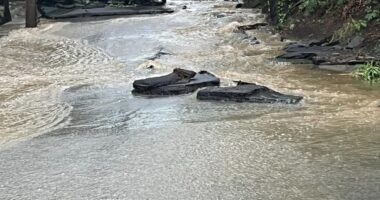
Daniel Jaffe Wilder still remembers the conversation he had maybe six years ago with a former colleague, when they were working at Garden in the Woods, the native-plant garden in Massachusetts.
The two ecologically focused horticulturists were looking for a way to talk to visitors about that massive monoculture of European turfgrass species that we grow and mow like mad. They wanted a catchy slogan, perhaps, to convince people that they could do better ecologically than the great American lawn — something encouraging, and not too intimidating.
You know, like “Kill Your Lawn.”
At first, that was just a working title. Then it became a sort of campaign, said Mr. Wilder, who is now the director of applied ecology at Norcross Wildlife Foundation, in Wales, Mass., and its 8,000-acre sanctuary. “Kill Your Lawn” took the form of a lecture that he and Mark Richardson, the director of horticulture at New England Botanic Garden at Tower Hill, have each given many times since.
Extreme as it sounds, it gets the audience’s attention.
“Our thoughts converged with a moment nationwide — a moment of increasing awareness of what lawns are doing to the environment, and even of lawn-shaming in some regions,” Mr. Wilder said.
Fast forward a few years, and a growing number of Americans have just completed No Mow May, a campaign inspired by one begun in 2019 by the British nonprofit group Plantlife. It’s a step toward new consciousness, yes, but what about the vast range of other possibilities — everything between “Kill Your Lawn” and not mowing for a single month?
“Destroying your lawn and planting a native ecosystem isn’t for everybody,” Mr. Wilder acknowledged, referring to the most ambitious turfgrass alternative. “And it might not be for most people.”
Hoping to offer a comfortable entry point for lawn owners of any interest level or budget, he proposes what he calls four “gradients of ecology,” each with pros and cons.
It’s no surprise that the conventional lawn, conventionally managed, doesn’t make an appearance on any level of his scale. Turfgrass lacks diversity and does not perform needed ecosystem services to wildlife. Our tens of millions of acres of it waste water and consume tons of chemicals.
Time for something a little (or much) better.
Under New Management
On most sites, it doesn’t work to just stop mowing, Mr. Wilder said: “It usually just yields tall lawn, plus weeds.”
For those not yet ready to surrender their lawns, his entry-level approach involves shifting how we care for them — to make them somewhat less of what the ecologist Douglas W. Tallamy calls “an ecologically dead status symbol.”
Simply raising the mower blade to a cutting height of three and a half or four inches, Mr. Wilder said, is a modest first step. Decreasing watering and skipping the chemicals helps, too. And top-dressing lawns with maybe half an inch of compost will increase the biological activity in the soil, supporting the grass naturally.
We also need to redefine what we consider a weed.
“The lawn-care industry convinced us that having clover is a bad thing in a lawn,” Mr. Wilder said. “But it’s a legume that naturally fixes nitrogen in the soil, reducing our need for fertilizer — so how is that bad?”
And at the elevated mowing height, white clover (Trifolium repens) and other “weeds” aren’t constantly beheaded and will bloom, producing some sustenance.
“Embrace some of what people call weeds,” Mr. Wilder said. “Having flowers in your lawn sounds quite nice to me.”
Not just clover, but also Eastern natives, including various violets (Viola species), spring’s tiny sky-colored bluets (Houstonia caerulea) and American self-heal (Prunella vulgaris subspecies lanceolata), a creeping purple-flowered mint relative.
But what about the best-known lawn weed, the dandelion (Taxaracum officinale), a Eurasian species?
“I’m torn on dandelions,” he admitted. They may get more credit than they deserve as a pollinator plant, and they do tend to take over.
“Native bees don’t need dandelions — they need those violets, self-heal and other natives,” Mr. Wilder said. “Dandelions might be a small step in the right direction, but we’re not solving the world’s problems with them.”
Easy Does It
Another step that could be taken alongside those maintenance tweaks is reducing the total square footage of lawn — turning a section into something else entirely, appropriate to the location and conditions.
A garden bed of native shrubs and perennials, perhaps. But be sure to choose simple, low-maintenance ones, Mr. Wilder said, like a grouping of highbush blueberry (Vaccinium corymbosum) underplanted with a ground cover like running groundsel (Packera obovata).
Or plant “a good edge species,” he suggested, instead of mixed wildflower strips, which are a bit more work. Consider prairie dropseed grass (Sporobolus heterolepis) in a sunny site or Pennsylvania sedge (Carex pensylvanica), a grass look-alike that can be mowed, in a shady spot.
Wild strawberry (Fragaria virginiana) produces small fruit and can take foot traffic. At Norcross, visitors are inspired by the possibilities suggested by a wild edible garden with a strawberry lawn beneath blueberries and other fruiting shrubs. The strawberry’s low foliage displays good autumn color, too.
Or maybe a native perennial offering an olfactory bonus? With anise hyssop (Agastache foeniculum) or mountain mint (Pycnanthemum muticum), a dose of aromatherapy wafts upward when you’re mowing the remaining grass, as the lawn mower brushes against the pollinator plants.
“If you could even transition 10 percent of your lawn to something else, and water the rest less — that’s a fantastic start,” Mr. Wilder said.
Don’t go too far too fast, though.
“There are a lot of reasons to start slow,” he noted. “The workload, yes, but also that it allows time to get to know the tools, the processes — and also the cost. If you try to do 100 percent, sometimes these lessons come really hard.”
Zeroing Out the Lawn, and Then What?
Ready for what Mr. Wilder calls a “huge step forward”? Replace your lawn with an “improved nonnative option,” often marketed as eco-lawn or low-mow lawn, like the mixes from Prairie Moon Nursery or Wildflower Farm.
These blends of cool-season fescues put on growth in spring and fall, rather than summer. And once they’re established, mowing once or twice a year — Mr. Wilder recommends late spring — is all that’s required.
Another alternative: clover, which can adapt to semi-shade and provides some pollinator benefits, because it flowers.
All are sown from seed, so the process is not an extravagant one. And the work is not too daunting, except for the first step: A blank canvas must be prepared to sow into.
“You need to zero out your lawn first,” Mr. Wilder said. “I’m not into digging up lawns — a lot of work without lots of benefits.”
Smothering the lawn for a couple of months is his go-to method, using cardboard or Ram Board (from the building-supply store), topped with a mix of wood chips and compost. A weighted-down tarp can yield similar results, but must be removed after it has done its job.
Nonnative lawns are “a good step in the right direction,” Mr. Wilder said, and establish themselves fairly quickly. “In a year, they’re pretty good — and the next year, even better.”
The Ultimate Direction: All Natives
Mr. Wilder looks forward to the day when the stuff of native lawn alternatives — his third ecological gradient — comes in big bags of seed, too.
For now, options like a Pennsylvania sedge lawn (supporting dozens of native caterpillars) or a lawn of wild strawberry (valuable to bees and even more caterpillars) must be planted with small landscape plugs. This process is costlier and requires not only eliminating the former lawn, but also waiting several years for the new lawn to fill in.
Native annuals like partridge pea (Chamaecrista fasciculata) or plains coreopsis (Coreopsis tinctoria) can be sown among the plugs as a nurse crop, for quicker diversity and cover, and to help outcompete the weeds while the perennials establish themselves.
At Norcross Wildlife Sanctuary, at the center of the critical Quabbin wildlife corridor between southern and northern New England, these principles are applied on a grander scale. All of the remaining lawns are being assessed to decide whether they stay or go — and if they go, what they turn into.
“No one size fits all for us, or anyone in this situation,” Mr. Wilder said. “Some will remain lawn, some native lawn, some something else entirely.”
Those “something else entirely” options are the fourth gradient: They don’t resemble lawns at all.
Certain old pastures may go in the native warm-season grassland direction; others will move toward a native forb-dominated meadow, or be allowed to reforest.
Mr. Wilder is going native at the home that he and his wife recently moved into, where they inherited “a giant hill of Vinca.” He weed-whacked and then smothered a big section with Ram Board, wood chips and compost, plugging in wild strawberry and self-heal plants, and thickly sowing partridge pea seed and other nurse crops for good measure.
“One-half smother, one-half competition diversity” is how he described this approach, which requires vigilant editing — and more cardboard wherever the Vinca resurfaces.
But he can visualize the end goal, he said: “Not what most people will think of as lawn.”
Margaret Roach is the creator of the website and podcast A Way to Garden, and a book of the same name.
For weekly email updates on residential real estate news, sign up here. Follow us on Twitter: @nytrealestate.
Source: | This article originally belongs to Nytimes.com









